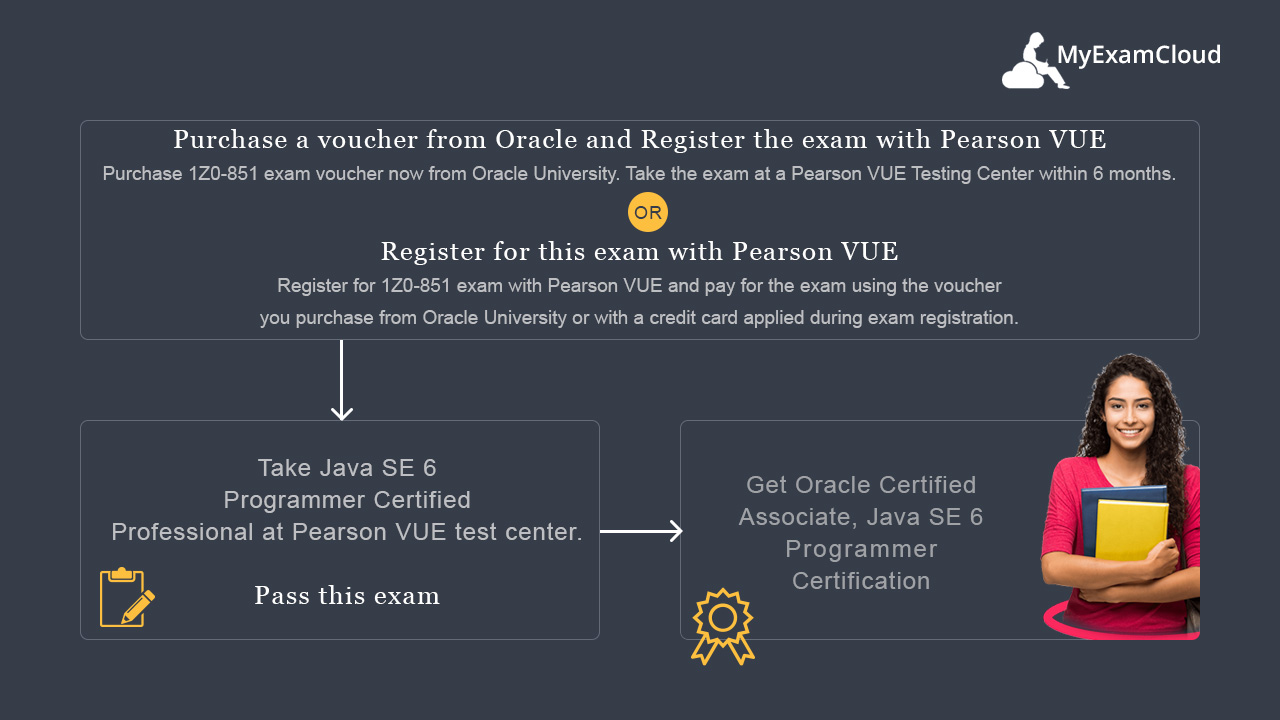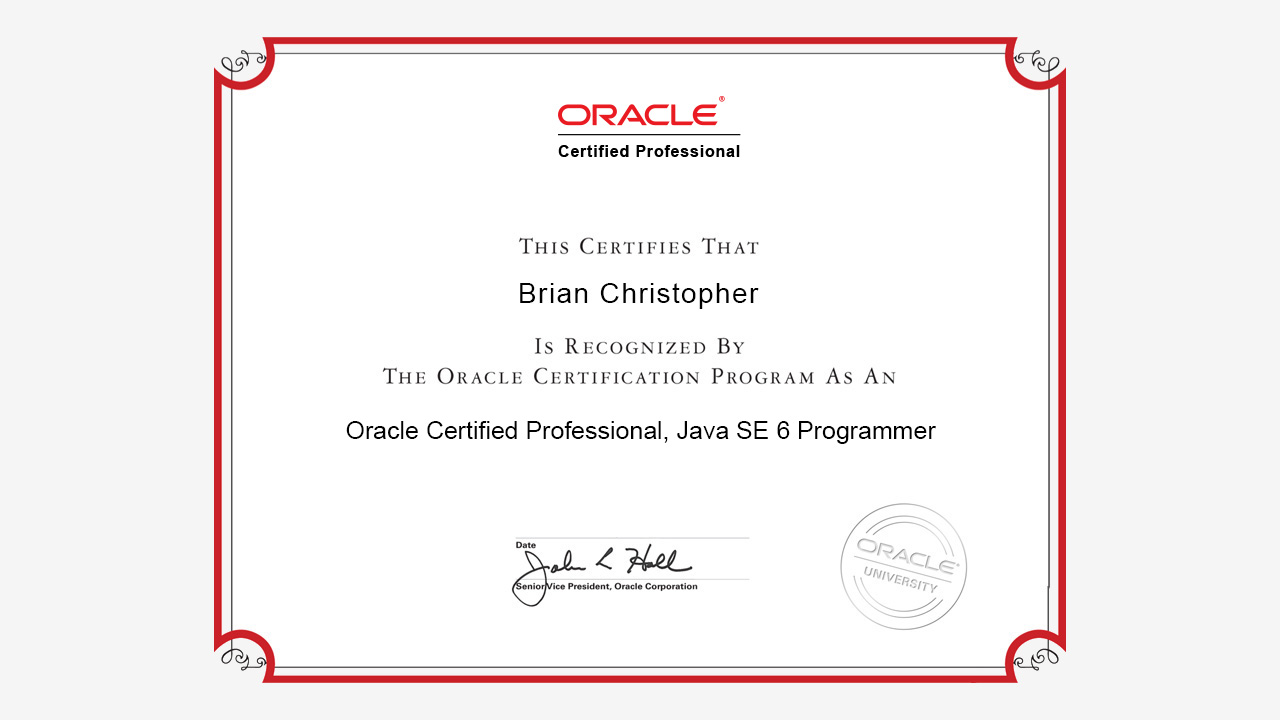27 OCPJP 6 Practice Questions - Free
You can access 27 Oracle Certified Professional Java SE 6 Programmer Practice Questions, from MyExamCloud Exam Simulator
Take Free Practice Testfor Oracle Certified Professional Java SE 6 Programmer Certification
MyExamCloud OCPJP 6 Practice Tests helps you to pass the exam in first attempt. Prepare with one of the best OCAPJP 6 Study Course developed by Java Certified Experts. 100% Test Pass Guarantee.
OCPJP 8 Upgrade (All Versions) Practice Tests and eBooks are available online at MyExamCloud Exam Simulator. This course contents can be accessed from PC, Mac, iPhone®, iPad®, Android™ Device. Mobile Apps available on iTunes and Android stores.
Inside MyExamCloud's OCPJP 6 Practice Course
Set Goals on OCPJP 6 exam topics
(MyExamCloud PPA Tracker)
6 Full length mock exams
(MyExamCloud Practice Exams)
1 Free Trial mock exam
(MyExamCloud Practice Exam)
1 Quiz Exams
(MyExamCloud Quiz Exams)
2 Flash Card Quiz Exams
(MyExamCloud Quiz Exams)
2 Study Notes
(MyExamCloud eBooks)
Study mode to access topic based questions
Exhaustive explanation with every question
Reports to assess performance history, strengths & weaknesses
Track your goals
Focus lab to pinpoint your weak areas
Unlimited lifetime Access
The OCPJP 6 Practice Questions and study notes are created by highly qualified and Java Certified experts. The Authors has created this online course covering all Java SE 6 Programmer Certified Professional exam objectives based on latest Oracle's changes.
The OCPJP 6 certification improves object-orientated programming and Java fundamental skills.

Passing this exam, one can achieve Java SE 6 Programmer Certified Professional from Oracle. The real exam tests your OO and Java SE 6 skills by Single and Multiple choice questions.
| Number of Questions: | 60 Questions |
|---|---|
| Exam Duration | 150 Minutes |
| Passing Score: | 61% |
| Exam Format | Multiple Choice (which can have single or multiple answers) |
| Validated Against | Java SE 5 & SE 6 |
| Exam Price | Price May vary from Country to country. Refer Oracle site for latest pricing. |
The real exam is a computer based test provided by pearsonvue and it can be taken from any local test centers in your country.
Set The New Java Standard With Java SE 6 OCP Certification: Java SE OCP certification is prerequisite for most of the advanced certifications. So it is good to have certified in Java SE 6 to attend advanced certifications. The Java SE 6 Oracle Certified Professional (OCP) certification provides a foundational understanding of Java as well as programming in general. So it suits for most Java Professionals starting from beginner to expert.
The following practice question is taken from MyExamCloud OCPJP 6 Study Plan.
|
Code: PayRoll.java import java.util.*;
What is the result of compiling and running the above code? ChoicesChoice A: Choice B: Choice C: Choice D: Choice E: Choice F: |
Answer and Explanation:Choice F is correctAll instances of a generic class have the same runtime class, regardless of their actual type parameters. So the Since no data has been added to both |
You can access 27 Oracle Certified Professional Java SE 6 Programmer Practice Questions, from MyExamCloud Exam Simulator
Take Free Practice TestWithin 30 minutes of completing your OCPJP 6 Certification exam, you will receive an email from Oracle notifying you that your exam results are available in CertView. If you have previously authenticated your CertView account, simply login and select the option to "See My New Exam Result Now."
If you have not authenticated your CertView account yet at this point, you will need to proceed with your account authentication.
Authentication requires an Oracle Single Sign On username and password and the following information from your Pearson VUE profile: email address and Oracle Testing ID. You will be taken to CertView to log in once your account has been authenticated.

The reason for taking Oracle Java Certification is to differentiate general programmers from certified experts. You may get additional benefits like getting a good job, salary hike, designation changes, role changes and higher promotion.
Stand out from the millions of Java crowd. Increase your marketability with OCPJP 8 Certification on the most used programming language in the world - Java.
Related Articles: https://www.epractizelabs.com/myexamcloud/2017/04/20/oracle-java-certification-exam-preparation/
Congrats, you have successfully scheduled your Java Certification exam.
The real exam questions assumes the following:
Missing package and import statements: If sample code do not include package or import statements, and the question does not explicitly refer to these missing statements, then assume that all sample code is in the same package, or import statements exist to support them.
No file or directory path names for classes: If a question does not state the file names or directory locations of classes, then assume one of the following, whichever will enable the code to compile and run:
Unintended line breaks: Sample code might have unintended line breaks. If you see a line of code that looks like it has wrapped, and this creates a situation where the wrapping is significant (for example, a quoted String literal has wrapped), assume that the wrapping is an extension of the same line, and the line does not contain a hard carriage return that would cause a compilation failure.
Code fragments: A code fragment is a small section of source code that is presented without its context. Assume that all necessary supporting code exists and that the supporting environment fully supports the correct compilation and execution of the code shown and its omitted environment.
Descriptive comments: Take descriptive comments, such as "setter and getters go here," at face value. Assume that correct code exists, compiles, and runs successfully to create the described effect.
|
Section 1: Declarations, Initialization and Scoping
Section 2: Flow Control
Section 3: API Contents
Section 4: Concurrency
Section 5: OO Concepts
Section 6: Collections / Generics
Section 7: Fundamentals
|

We purchased the exams for every one of our training members to prepare SCJP. For the first time, we got 100% success. Keep up the good work and THANK YOU.